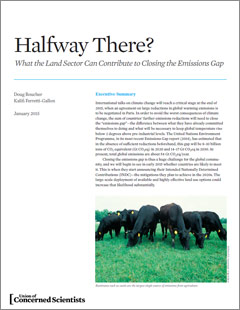Over the past several years, scientific analyses have clearly demonstrated that there is a large “emissions gap” between the reductions in global warming pollution that are needed and the reductions that countries have pledged to make. Closing this large and widening gap is vital to preventing the worst consequences of climate change. How can this be done?
Halfway There? shows that the land sector—global agriculture and forests—can make a large contribution to closing the gap. The report estimates potential land-sector climate mitigation from each of the largest countries, making up 57% of global emissions from the sector.
The role of land use in closing the gap
According to the IPCC, emissions from agriculture, forestry, and other land use (AFOLU) now represent about 24 percent of global warming pollution. The activities that make up this sector include some of the most fundamental aspects of human existence: how we feed, house and clothe ourselves; how we relate to other species; and how we see our place in the world.
There are three broad AFOLU alternatives for reducing global warming emissions:
Agricultural emissions produce 5.0 to 5.8 billion metric tons of CO2 equivalent (Gt CO2eq) per year, according to the most recent IPCC estimate. More than half of this total comes from livestock, particularly methane-emitting ruminants such as beef cattle.
Deforestation, forest degradation, and clearing peat account for an estimated 4.3 to 5.5 Gt CO2eq per year. Enormous amounts of carbon are released into the atmosphere when forests are cleared. “Forest degradation” activities, such as selective logging, and drainage of carbon-rich peat swamps are also significant emissions sources.
Carbon sequestration. Unlike most sectors that contribute to global warming, land use offers opportunities not only to reduce emissions, but to remove carbon from the atmosphere and store it. Reforestation is the main alternative here, but other kinds of ecosystem restoration could contribute as well.
The major countries
While every country can contribute something to the effort to close the gap, Halfway There? identifies eight countries with large climate mitigation potential. The table below shows the estimated potential for each country in 2020 and 2030.
Each country’s mitigation formula will need to emphasize different opportunities—reducing emissions from the forest sector (Indonesia); increasing sequestration (Brazil); dietary shifts and food waste reduction (the United States and, to a lesser extent, the EU); and increased efficiency in crop and livestock production (India and China).
But together, these nations account for the majority of AFOLU emissions, and they could close a substantial portion of the emissions gap if they act boldly.




